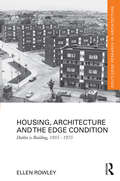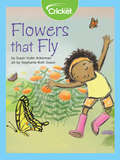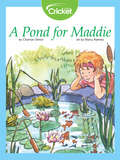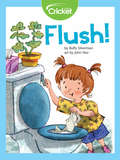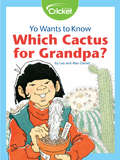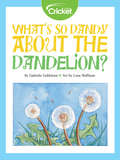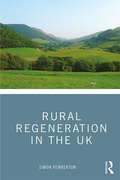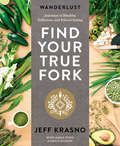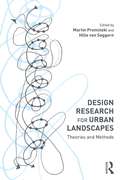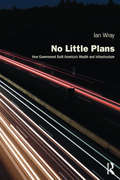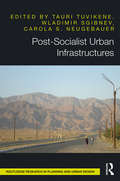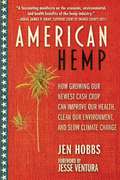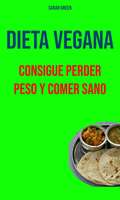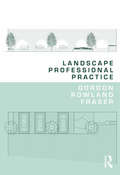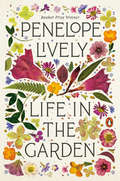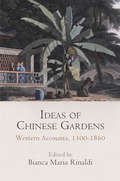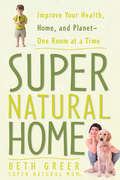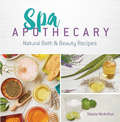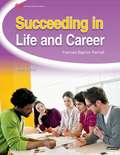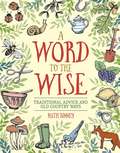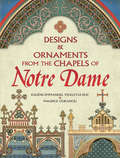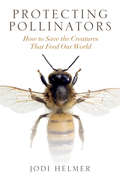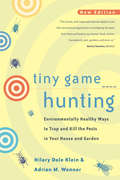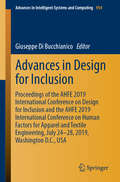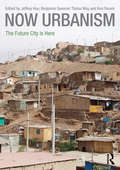- Table View
- List View
Housing, Architecture and the Edge Condition: Dublin is building, 1935 - 1975 (Routledge Research in Architecture)
by Ellen RowleyThis book presents an architectural overview of Dublin’s mass-housing building boom from the 1930s to the 1970s. During this period, Dublin Corporation built tens of thousands of two-storey houses, developing whole communities from virgin sites and green fields at the city’s edge, while tentatively building four-storey flat blocks in the city centre. Author Ellen Rowley examines how and why this endeavour occurred. Asking questions around architectural and urban obsolescence, she draws on national political and social histories, as well as looking at international architectural histories and the influence of post-war reconstruction programmes in Britain or the symbolisation of the modern dwelling within the formation of the modern nation. Critically, the book tackles this housing history as an architectural and design narrative. It explores the role of the architectural community in this frenzied provision of housing for the populace. Richly illustrated with architectural drawings and photographs from contemporary journals and the private archives of Dublin-based architectural practices, this book will appeal to academics and researchers interested in the conditions surrounding Dublin’s housing history.
Flowers that Fly
by Susan Yoder AckermanSimon teaches his little cousin Adeline about how to grow a garden that will attract beautiful butterflies.
A Pond for Maddie
by Charnan SimonWhat is the difference between and man-made pond and a natural pond? Maddie learns all about ponds while she and her family bring an artificial pond back to life.
Flush!
by Buffy SilvermanExplore the world of plumbing when Andy and Lizzie learn how the pipes in their house work. Some pipes carry out dirty water while others carry in clean water.
Yo Wants to Know: Which Cactus for Grandpa?
by Lea DanielGrandpa teaches Yo about how cactuses grow, thrive, and protect themselves.
What's So Dandy About the Dandelion?
by Gabriele GoldstoneThe name dandelion comes from the French for "tooth of the lion." But are these flowers actually dangerous?
Rural Regeneration in the UK
by Simon PembertonRural Regeneration in the UK provides an accessible yet critical overview of rural regeneration policy and governance in the UK. It charts the key patterns and processes of rural change since 1945 and the emergence and evolution of rural regeneration policy and governance in shaping rural spaces. A key objective of the book is to highlight how, and to what extent, rural regeneration policy and governance are responsive to an increasingly differentiated and uneven rural economy and society. Part One considers the context for rural regeneration, including theoretical frameworks of relevance and the ways in which rural regeneration policy and governance have been framed. In particular, it includes a consideration of how the rural has been made ‘thinkable’, and the extent to which this has moved beyond traditional concerns with agricultural development. Part Two highlights the key dimensions and spaces of rural regeneration. This includes responses to rural change from ‘within the rural’, including community-led approaches, the use of culture and the extent to which approaches may be converging or diverging within a devolved UK. Rural Regeneration in the UK provides a comprehensive and integrated analysis of responses to rural change that will appeal to a broad audience of students, scholars and practitioners both in the UK and abroad.
Wanderlust Find Your True Fork: Journeys in Healthy, Delicious, and Ethical Eating
by Jeff Krasno Maria Zizka Grace EdquistFrom Jeff Krasno, author of Wanderlust and creator of the wildly popular Wanderlust festivals, comes the foodie’s roadmap to making responsible, ethical decisions about food—you don’t have to be a yogi to try out these delicious, organic, and seasonal recipes. Wanderlust Find Your True Fork answers all the questions you have about eating a healthy, whole foods diet, explaining how to start an urban garden, providing composting techniques, and demystifying biodynamic agriculture. It’s the definitive guide to developing a closer connection to what you eat.With the help of an all-star cast of chefs and wellness influencers (including Jessica Koslow, Deborah Madison, Jason Wrobel, and Guy Turland) that contribute expert advice, the book has yummy recipes for vegans, vegetarians, omnivores, and everything in between. Being conscious about what we put in our bodies is a cornerstone of living a balanced life, and with Wanderlust Find Your True Fork you can take that passion for healthy living off the mat and onto the plate.
Design Research for Urban Landscapes: Theories and Methods
by Martin Prominski Hille SeggernWithin the spatial design disciplines, research through design as a tool and practice has often been neglected. This book provides a much-needed companion to the theories, methods and processes involved in using design-based research in landscape, architecture and urban design. Aimed specifically at researchers completing PhD projects, supervisors and designers working in practice, it covers applied approaches to help you to use design research in your work. With fully illustrated examples of original international design research PhDs from a variety of programme types, such as individual, structured and practice-based, Design Research for Urban Landscapes offers PhD candidates and supervisors a clear foundational pathway.
No Little Plans: How Government Built America’s Wealth and Infrastructure (Planning, History and Environment Series)
by Ian WrayIs planning for America anathema to the pursuit of life, liberty and happiness? Is it true, as ideologues like Friedrich Von Hayek, Milton Friedman, and Ayn Rand have claimed, that planning leads to dictatorship, that the state is wholly destructive, and that prosperity is owed entirely to the workings of a free market? To answer these questions Ian Wray’s book goes in search of an America shaped by government, plans and bureaucrats, not by businesses, bankers and shareholders. He demonstrates that government plans did not damage American wealth. On the contrary, they built it, and in the most profound ways. In three parts, the book is an intellectual roller coaster. Part I takes the reader downhill, examining the rise and fall of rational planning, and looks at the converging bands of planning critics, led on the right by the Chicago School of Economics, on the left by the rise of conservation and the ‘counterculture’, and two brilliantly iconoclastic writers – Jane Jacobs and Rachel Carson. In Part II, eight case studies take us from the trans-continental railroads through the national parks, the Federal dams and hydropower schemes, the wartime arsenal of democracy, to the postwar interstate highways, planning for New York, the moon shot and the creation of the internet. These are stories of immense government achievement. Part III looks at what might lie ahead, reflecting on a huge irony: the ideology which underpins the economic and political rise of Asia (by which America now feels so threatened) echoes the pragmatic plans and actions which once secured America’s rise to globalism.
Post-Socialist Urban Infrastructures
by Tauri Tuvikene Wladimir Sgibnev Carola S. NeugebauerPost-Socialist Urban Infrastructures critically elaborates on often forgotten, but some of the most essential, aspects of contemporary urban life, namely infrastructures, and links them to a discussion of post-socialist transformation. As the skeletons of cities, infrastructures capture the ways in which urban environments are assembled and urban lives unfold. Focusing on post-socialist cities, marked by neoliberalisation, polarisation and hybridity, this book offers new and enriching perspectives on urban infrastructures by centering on the often marginalised aspects of urban research—transport, green spaces, and water and heating provision. Featuring cases from West and East alike, the book covers examples from Azerbaijan, Bulgaria, Serbia, Croatia, Germany, Russia, Georgia, Lithuania, Poland, the Czech Republic, Tajikistan, and India. It provides original insights into the infrastructural back end of post-socialist cities for scholars, planners and activists interested in urban geography, cultural and social anthropology, and urban studies.
American Hemp: How Growing Our Newest Cash Crop Can Improve Our Health, Clean Our Environment, and Slow Climate Change
by Jen HobbsIf there ever was a time to build an American hemp industry, the time is now.In Jesse Ventura’s Marijuana Manifesto, former Minnesota Governor teamed up with Jen Hobbs to explain why it’s time to fully legalize cannabis and end the War on Drugs. Through their research, it became clear that hemp needed its own manifesto. Jen Hobbs takes up this torch in American Hemp.December of 2018 marked a largely unprecedented victory for cannabis. The 2018 Farm Bill passed and with it hemp became legal. What the federal government listed for decades as a schedule 1 narcotic was finally classified as an agricultural crop, giving great promise to the rise of a new American hemp industry. Filled with catchall research, American Hemp examines what this new domestic crop can be used for, what makes it a superior product, and what made it illegal in the first place; the book also delves into the many health and medical benefits of the plant. Hobbs weighs in on how hemp can improve existing industries, from farming to energy to 3D printing, plus how it can make a serious impact on climate change by removing toxins from the soil and by decreasing our dependence on plastics and fossil fuels.American Hemp lays out where we are as a nation on expanding this entirely new (yet ancient) domestic industry while optimistically reasoning that by sowing hemp, we can grow a better future and save the planet in the process.
Dieta Vegana : Consigue Perder Peso Y Comer Sano
by Sarah GreenEste libro contiene pasos y estrategias para encontrar recetas veganas que se adapten a cada persona. En este libro se analiza detalladamente el estilo de vida vegano. No hay que aguantar el seguir comiendo alimentos blandos o desagradables. Este libro está enfocado en que las personas veganas aprendan a preparar deliciosos platos ricos en nutrientes necesarios para llevar una vida saludable. Una comida equilibrada puede conseguirse si pones en marcha las recetas que se dan en este lirbo. Hacerse vegano a muchas personas les parece algo muy complicado de conseguir. Dejar de lado tus comidas favotiras que contengan carne o dejar el azúcar refinado no suena sencillo, Sin embargo, las recetas que se dan en este libto prueban que el mito no es cierto. Podrás disfrutar de un desayuno, cena e incluso postre delicioso y sabroso mientras mantienes una dieta vegana. Si quieres perder peso, sentirte enérgico y vivir una vida más sana, necesitas cambiar tu dieta y comenzar a comer más saludable diariamente y no un arreglo rápido de un problema de peso. Esto es de lo que se trata ser vegano, es una forma de vida. Si quieres hacerte vegano y no estás muy segura de lo que conlleva, que comer, que evitar u que recetas increíbles puedes preparar, entonces este es tu libro.
Landscape Professional Practice
by Gordon Rowland FraserGraduate of the Royal Botanic Gardens, Kew, Chartered Landscape Architect, MBA and Barrister, Gordon Rowland Fraser draws upon 30 years of project management, professional practice and teaching experience to provide an uncomplicated and intuitive guide to the business aspects of the landscape profession. An indispensable reference for seasoned professionals, the book will enable the student or novice practitioner to turn their drawing board inspiration into reality without being overwhelmed or afraid of overseeing the implementation of their proposals. Guided by the Landscape Institute’s 2013 Pathway to Chartership syllabus, this structured, step-by-step, narrative guide sets out the documentation commonly used within the landscape profession and makes accessible a logical and sequential understanding of contractual relationships; procurement strategies; processes of preparing client estimates and obtaining competitive quotations; of preparing contract documentation and administering formal contracts; general concepts of law as they relate to land management and the landscape profession; of business administration, market appraisal and positioning; and of the landscape consultant’s appointment. As an understanding of professional practice is intrinsic to all Landscape Institute accredited courses, this is an essential text for every landscape architecture student during their education and their subsequent journey into professional practice. Those undertaking Garden Design Diplomas will similarly find the book invaluable as they venture into the world of creativity and commerce, while the seasoned practitioner will find it a comprehensive point of reference to add to their bookshelf.
Life in the Garden
by Penelope LivelyFrom the Booker Prize winner and national bestselling author, reflections on gardening, art, literature, and lifePenelope Lively takes up her key themes of time and memory, and her lifelong passions for art, literature, and gardening in this philosophical and poetic memoir. From the courtyards of her childhood home in Cairo to a family cottage in Somerset, to her own gardens in Oxford and London, Lively conducts an expert tour, taking us from Eden to Sissinghurst and into her own backyard, traversing the lives of writers like Virginia Woolf and Philip Larkin while imparting her own sly and spare wisdom. "Her body of work proves that certain themes never go out of fashion," writes the New York Times Book Review, as true of this beautiful volume as of the rest of the Lively canon.Now in her eighty-fourth year, Lively muses, "To garden is to elide past, present, and future; it is a defiance of time."
Ideas of Chinese Gardens: Western Accounts, 1300-1860 (Penn Studies in Landscape Architecture)
by Bianca Maria RinaldiEuropeans may be said to have first encountered the Chinese garden in Marco Polo's narrative of his travels through the Mongol Empire and his years at the court of Kublai Khan. His account of a man-made lake abundant with fish, a verdant green hill lush with trees, raised walkways, and a plethora of beasts and birds took root in the European imagination as the description of a kind of Eden. Beginning in the sixteenth century, permanent interaction between Europe and China took form, and Jesuit missionaries and travelers recorded in letters and memoirs their admiration of Chinese gardens for their seeming naturalness. In the eighteenth century, European taste for chinoiserie reached its height, and informed observers of the Far East discovered that sophisticated and codified design principles lay behind the apparent simplicity of the Chinese garden. The widespread appreciation of the eighteenth century gave way to rejection in the nineteenth, a result of tensions over practical concerns such as trade imbalances and symbolized by the destruction of the imperial park of Yuanming yuan by a joint Anglo-French military expedition.In Ideas of Chinese Gardens, Bianca Maria Rinaldi has gathered an unparalleled collection of westerners' accounts, many freshly translated and all expertly annotated, as well as images that would have accompanied the texts as they circulated in Europe. Representing a great diversity of materials and literary genres, Rinaldi's book includes more than thirty-five sources that span centuries, countries, languages, occupational biases, and political aims. By providing unmediated firsthand accounts of the testimony of these travelers and expatriates, Rinaldi illustrates how the Chinese garden was progressively lifted out of the realm of fantasy into something that could be compared with, and have an impact on, European traditions.
Super Natural Home: Improve Your Health, Home, and Planet--One Room at a Time
by Beth Greer“An invaluable book, filled with practical solutions on how to eat healthier, breathe cleaner air, and transform your home into a safe haven, free from toxic chemicals.”—Deepak Chopra From eliminating chemicals in your food and water to choosing clean beauty products, let the Super Natural Mom teach you everything you need to know to “live clean” in a toxic world! Beth Greer had been living what she considered a healthy lifestyle when a medical crisis prompted her to reevaluate everything—from the food she ate to the personal-care products she used and the environment she lived in. Now, in Super Natural Home, she shows the alarming extent of the dangerous chemicals we unwittingly expose ourselves to every day. As she did in her own life, she invites readers to put their lives under a microscope. The straightforward, solutions-based approach of Super Natural Home—complete with quizzes to help identify and correct potential toxic hot zones—speaks directly to what environment-conscious consumers really need: ultra-practical advice on what they can do right now to limit exposure to the poisons that are endangering them and their children. At a time when impeccable scientific research points to an alarming correlation between common chemical compounds and cancers, allergies, psychiatric disorders, and birth defects, among other serious health concerns, Super Natural Home gives consumers the tools to start protecting themselves and their families. Praise for Super Natural Home “Beth Greer’s clear, comprehensive, and practical book is a godsend for anyone living in America who wants to make a real impact on reducing the pollutions and poisons that are ubiquitous in our surroundings. She’s full of good humor, yet will help you live a far cleaner and more wholesome life than you might have thought possible. Hats off to her. Read this book.”—Peter Coyote, actor and author“Making simple changes can often have a profound impact not only on you and your family’s health but also on the planet. Beth Greer has done a fabulous job of creating a practical resource that will let you know what these changes are and how to easily implement them.”—Joseph Mercola, DO, founder of Mercola
Spa Apothecary: Natural Bath & Beauty Recipes
by Stasie McArthurYou can make luxurious products for skin, hair, and bath at home! All you need are basic cooking skills, a few simple kitchen tools, some common household ingredients — and this easy-to-follow guide. Spa Apothecary is a great resource for those who want to avoid the chemical additives of commercial products. Best of all, it will assist you in transitioning to a healthier, natural beauty routine and save you money, too!Author Stasie McArthur explains how to build your own personal apothecary. There is a supply list and more than 100 simple, preservative-free recipes, along with a helpful tip for each one. Included are moisturizers and toners for face and hand care, washes and scrubs for skin and body, shampoos and conditioners, and healing compounds for congestion and earaches. These handmade products make great gifts for family and friends — and can be customized with favorite scents and textures.
Succeeding in Life and Career: Foundations Of Human Studies
by Frances Baynor ParnellNIMAC-sourced textbook
A Word to the Wise: Traditional Advice and Old Country Ways
by Ruth BinneyIf you've ever wondered whether carrots improve your vision (they do) and why elephants have great memories, consult A Word to the Wise. You'll discover that it's never too late to learn from a proverb or an old wives' tale. This captivating book is a fascinating compilation of age-old expressions and customs, and its insights cover everything from health tips and kitchen tricks to gardening know-how and hints for predicting the weather.Folklorist Ruth Binney explains the truth behind such traditions as polishing windows with newspaper and blowing out birthday candles in a single breath. She also discusses whether classic adages are still relevant or, like eating oysters only in "R" months, their truths have faded with the passage of time. This charmingly illustrated volume of enduring wisdom makes a splendid keepsake as well as a fine gift.
Designs and Ornaments from the Chapels of Notre Dame (Dover Pictorial Archive Ser.)
by Eugene-Emmanuel Viollet-le-Duc Maurice OuradouArchitect and theorist Eugene-Emmanuel Viollet-le-Duc (1814–79), a prominent leader in the French Gothic Revival, was active in the restoration of medieval buildings. In 1845 he undertook one of the greatest projects in the history of restoration: the cleansing and restoration of the Cathedral of Notre-Dame in Paris. For the next twenty-three years he labored at his task, returning the cathedral to its original beauty and charm.This volume is based on a faithful reproduction of the restored mural paintings of the chapels, notable for their originality of design and the soft and subtle harmony of their coloring. The 60 full-page plates lend themselves to numerous graphic arts applications.
Protecting Pollinators: How to Save the Creatures that Feed Our World
by Jodi HelmerWe should thank a pollinator at every meal. These diminutive creatures fertilize a third of the crops we eat. Yet half of the 200,000 species of pollinators are threatened. Birds, bats, insects, and many other pollinators are disappearing, putting our entire food supply in jeopardy. In North America and Europe, bee populations have already plummeted by more than a third and the population of butterflies has declined 31 percent.Protecting Pollinators explores why the statistics have become so dire and how they can be reversed. Jodi Helmer breaks down the latest science on environmental threats and takes readers inside the most promising conservation initiatives. Efforts include famers reducing pesticides, cities creating butterfly highways, volunteers ripping up invasive plants, gardeners planting native flowers, and citizen scientists monitoring migration. Along with inspiring stories of revival and lessons from failed projects, readers will find practical tips to get involved. They will also be reminded of the magic of pollinators—not only the iconic monarch and dainty hummingbird, but the drab hawk moth and homely bats that are just as essential. Without pollinators, the world would be a duller, blander place. Helmer shows how we can make sure they are always fluttering, soaring, and buzzing around us.
Tiny Game Hunting: Environmentally Healthy Ways to Trap and Kill the Pests in Your House and Garden
by Courtlandt Johnson Hilary Dole Klein Adrian M. WennerEvery year Americans use a staggering five hundred million pounds of toxic pesticides in and around their homes, schools, parks, and roads--a growing health risk for people and the environment. But are these poisons really necessary? This book, appealing to the hunter in us all, shows how to triumph in combat with pests without losing the war to toxic chemicals. Tiny Game Hunting, written in a lively and entertaining style and illustrated with detailed drawings, gives more than two hundred tried-and-true ways to control or kill common household and garden pests without using toxic pesticides.
Advances in Design for Inclusion: Proceedings of the AHFE 2019 International Conference on Design for Inclusion and the AHFE 2019 International Conference on Human Factors for Apparel and Textile Engineering, July 24-28, 2019, Washington D.C., USA (Advances in Intelligent Systems and Computing #954)
by Giuseppe Di BucchianicoThis book addresses a range of topics in design, such as universal design; design for all; digital inclusion; universal usability; and accessibility of technologies regardless of users’ age, financial situation, education, geographic location, culture and language. It especially focuses on accessibility for people with auditory, cognitive, neurological, and visual impairments, ageing populations, and mobility for those with special physical needs. The book explores some of the overlaps between inclusive design and web accessibility to help managers, designers, developers, policy makers, and researchers optimize their efforts in these areas. Based on the AHFE 2019 International Conference on Design for Inclusion, held on July 24-28, held in Washington D.C., USA, it discusses new design technologies and highlights the disparate needs of the individuals within a community. Thanks to its multidisciplinary approach, it provides readers with various backgrounds with a timely, practice-oriented guide to design for inclusion.
Now Urbanism: The Future City is Here
by Jeffrey Hou Benjamin Spencer Thaisa Way Ken YocomAfter more than a century of heroic urban visions, urban dwellers today live in suburban subdivisions, gated communities, edge cities, apartment towers, and slums. The contemporary cities we know are more often the embodiment of unexpected outcomes and unintended consequences rather than visionary planning. As an alternative approach for rethinking and remaking today’s cities and regions, this book explores the intersections of critical inquiry and immediate, substantive actions. The contributions inside recognize the rich complexities of the present city not as barriers or obstacles but as grounds for uncovering opportunity and unleashing potential. Now Urbanism asserts that the future city is already here. It views city making as grounded in the imperfect, messy, yet rich reality of the existing city and the everyday purposeful agency of its dwellers. Through a framework of situating, grounding, performing, distributing, instigating, and enduring, these contributions written by a multidisciplinary group of practitioners and scholars illustrate specificity, context, agency, and networks of actors and actions in the re-making of the contemporary city.
